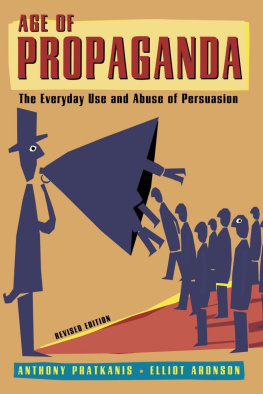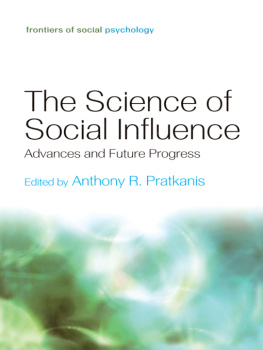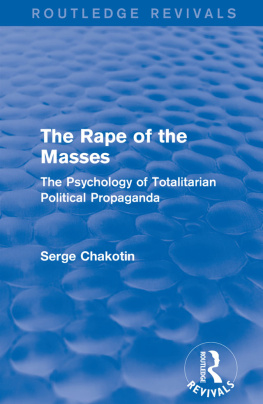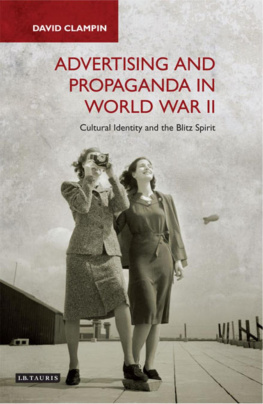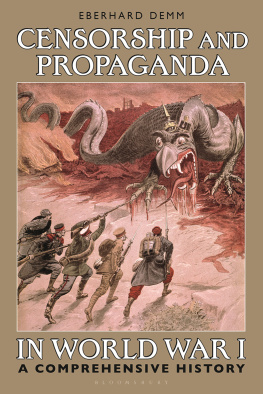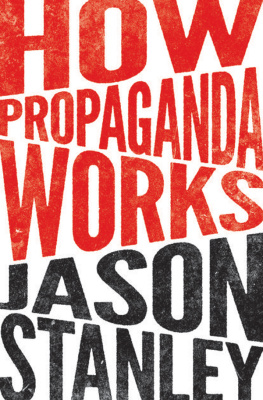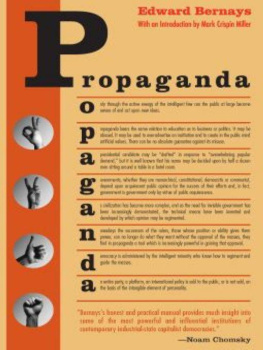AGE OF PROPAGANDA
TheEveryday Use and Abuse of Persuasion
REVISED EDITION
ANTHONY R. PRATKANIS and ELLIOT ARONSON
University of California, Santa Cruz
To the memory of my parents, Harry Aronson (1903-1950) and Dorothy Aronson (1901-1989)
Theyhad a wonderfully innocent, childlike trust that, in this country,almost everything they read (especially if it was between the coversof a book) was absolutely true.
E.A.
Tomy son, Tony T. Pratkanis (born 1991)
Chancesare, he will grow up with a healthy skepticism but a regrettablecynicism about the truth of everything he reads, hears, and sees.
A.R. P.
WHYWE WROTE THIS BOOK
Weare of different generations. One of us (E. A.) was born in 1932 andgrew up during World War II. "At that time, I fervently believedjust about everything I was exposed to in school and in the media.For example, I knew that all Germans were evil and that all Japanesewere sneaky and treacherous, while all white Americans wereclean-cut, honest, fair-minded, and trusting. Perhaps you had to beeleven years old to take seriously the racial and nationalcaricatures presented in the war movies of the early 1940s. But inthose days, most grown-upsincluding my parents (to whom thisbook is dedicated)certainly wanted to believe in the basicmessage of the war movies and did, in fact, have a childlike trust inthe media. They hung on every word President Roosevelt said in hisfamous fireside chats and never dreamed of questioning the nobilityof the motives behind our national policy. They thought (and so didI) that the purpose of commercial advertising was to inform theconsumer."
Theworld has taken a few turns since then. A. R. P. grew up during theVietnam war and was witness to the blatant lying by public officialsof that era. "At the time, I sat riveted to my televisionscreen, scared to death by the images of death and destruction beamedinto my living room from Vietnam, all the while learning thatpoliticians only lie when their lips move. I came of age during theWatergate era when a sitting president, Richard Nixon, was forced toresign when faced with incontrovertible evidence (some of it suppliedby his own tape recordings) of the lying, dirty tricks, and attemptedcover-up that he and his cronies had perpetrated on the Americanpeople. For me, commercials, whether for different brands of productsor different brands of politicians, were entertainment designed tomake someone rich or more powerful."
Inthe first edition of this book, we lamented the fact that there wasno White House tape recorder in use during the 1980sso thatPresident Reagan escaped the consequences of deceiving the Americanpeople (and the world) by subverting the Constitution through thecovert sale of arms to Iran and the diversion of the profits fromthat sale to support the Nicaraguan Contras.1 We felt (andcontinue to feel) it to be a sad commentary on our times that,although the majority of the American people were furious at Nixonand his cronies, by the time of the Iran-Contra scandal mostAmericans seemed to have developed a more cynical attitude aboutbeing deceived and did not seem displeased when Oliver North, JohnPoindexter, and President Reagan himself succeeded, for the mostpart, in "beating the rap." And now, ho hum, otherinvestigations come alongthe savings and loan debacle, theBCCI crisis, Ruby Ridge, and various shady campaign contributionsgiven to U.S. politicians of every stripe. Who cares? Business asusual. Such cynicism carries a price. A cynical electorate is alackadaisical electorate, as evidenced by the fact that fewer than50% of eligible Americans now bother to vote.
Andthen there was the world-famous slow-speed chase, the media circus ofthe centurythe trial of O. J. Simpson.2 Aninternational audience sat riveted to their TV sets as an army ofmore than 1,000 credentialed reporters plus untold media pundits wentover and over and over every excruciating detail of the case and thestoryfrom the cost of the trial to the menu at the MezzalunaRestaurant to Marcia Clark's topless vacation on the French Riviera.CNN alone employed 70 correspondents and 250 legal experts to produce1,530 hours of O. J. trial coverage and commentary. O. J. trinketvendors made more than $1 billion selling such treasures as noveltySimpson wrist watches, T-shirts, orange-scented O. J. air fresheners,and Judge Ito Jell-0 molds. From January 1, 1995, until the weekafter the verdict, television network news spent twenty-six hours andfifty minutes, or 13.6% of the available airtime, covering the O. J.story. That is more time than was devoted to Bosnia (thirteen hoursand one minute), the bombing in Oklahoma City (eight hours andfifty-three minutes), and the U.S. budget (three hours andthirty-nine minutes)the other top three "news"storiescombined.
Andafter the O. J. verdict was rendered, what was the news media to do?The trial had been a cash cow. The coverage was relatively cheap toproduce, garnered great ratings, and brought in top advertisingrevenues. For example, the television networks charged advertisersten times their normal rate for thirty seconds of commercial timeduring the O. J. verdict. What would top a juicy, intriguing trial ofa prominent athlete? What would keep the advertising revenue flowing?How about an impeachment trial of a U.S. president for sex crimes?
Andthat is what we watched next. Beginning in January of 1998, thenation's mass media, particularly its news programming, launchedaround-the-clock coverage of stories and speculation aboutthen-President Clinton's sexual misconduct, especially with a WhiteHouse intern named Monica Lewinsky.3 The number of jokestold about Bill Clinton on late-night TV soared a whopping 111.3 %during the year of the saga. An estimated 67.6 million Americanswatched Clinton's televised speech on August 17, 1998, in which headmitted an inappropriate relationship with Monica Lewinsky. In themonth just before this announcement, the network morning news showsdevoted 179 segments to the Clinton sex scandal and only 56 segmentsto any other news about the Clinton administration. Much of thiscoverage bordered on the hysterical, with rumor chasing gossipchasing innuendomuch like the coverage of the O. J. trial. Forexample, a panelist on CNBC stated that the president had had sexwith four other interns besides Lewinsky, ABC News reported thatClinton and Lewinsky had been caught in the act, possibly by SecretService agents, and then the Dallas Morning News followed upwith news that an agent was ready to testify that he saw thepresident and Lewinsky engage in a sex act. Of course, these stillunsubstantiated rumors were repeated over and over again by the newsmedia, giving them an air of respectability. Amidst this media roar,President Clinton infamously shook his finger at the American publicand denied having sex with "that woman."
Whatwere the reactions of Americans to having their news shows turnedinto the "All Monica, All the Time" network? Bill Clinton'sapproval ratings soared during the period. Newt Gingrich and otherswho led the impeachment charge lost favor with the American public(with some being forced to leave government because of their ownrevealed sexual indiscretions). Opinion polls showed that Americanshad lost respect for the news media and did not like the way the sagawas covered. We think the most telling statistic of all is this: QVC,the "All Shopping, All the Time" TV network posted thesecond-highest sales week in its history immediately after the August17 admission by Clinton. Apparently, many of those 67.6 millionAmericans who tuned in to hear Clinton went channel surfing withoutdelay after the pronouncement and settled on QVC as an alternative tothe "news" coverage. It was as if American citizens weresaying, "I am sick and tired of the blather. I am goingshopping."

